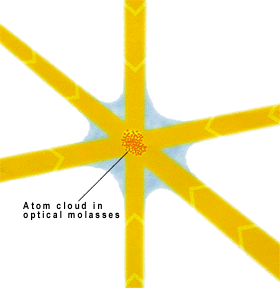Davis–Putnam algorithm: Difference between revisions
en>Helpful Pixie Bot m ISBNs (Build KC) |
en>Ugog Nizdast m Reverted 1 edit by Dorybadboy identified as test/vandalism using STiki |
||
| Line 1: | Line 1: | ||
[[Image:Molasses.gif|350px|thumb|Optical Molasses Schematic]] | |||
'''Optical molasses''' is a [[laser cooling]] technique that can cool down neutral [[atom]]s to temperatures colder than a [[magneto-optical trap]] (MOT). An optical molasses consists of 3 pairs of counter-propagating circularly polarized laser beams intersecting in the region where the atoms are present. The main difference between optical molasses and a MOT is the absence of magnetic field in the former. While a typical Sodium MOT can cool atoms down to 300μK, optical molasses can cool the atoms down to 40μK, an order of magnitude colder. | |||
==History== | |||
When laser cooling was proposed in 1975, a theoretical limit on the lowest possible temperature was predicted. Known as the '''Doppler Limit''', <math> T_d= \hbar \Gamma / {2 k_b} </math>, this was given by the lowest possible temperature attainable considering the cooling of two-level atoms by Doppler cooling and the heating of atoms due to momentum diffusion from the scattering of laser photons. Here, <math> \Gamma </math>, is the natural line-width of the atomic transition, <math> \hbar </math>, is Planck's constant and, <math> k_b </math>, is Boltzmann's constant. | |||
Experiments at the [[National Institute of Standards and Technology]], Gaithersburg, found the temperature of cooled atoms to be well below the theoretical limit. Initially, it was a surprise to theorists, until the full explanation came out. | |||
==Theory== | |||
The best explanation of the phenomenon of optical molasses is based on the principle of polarization gradient cooling. Counterpropagating beams of circularly polarized light cause a standing wave, where the [[light polarization]] depends on the spatial location. The AC [[Stark Effect|Stark Shift]] of atoms in different [[Fine structure|magnetic sub-levels]] is also spatially dependent. The basic idea is that atoms moving with a velocity climb a polarization gradient hill, thereby losing their velocity. At the top of the hill, atoms are resonant with the other molasses beams, absorb a photon and decay into a lower energy magnetic sub-level, thereby having shed some of their velocity. {{Citation needed|reason=I believe that this is Sisyphus cooling. Optical Molasses is an extension of Doppler cooling|date=April 2011}} | |||
==References== | |||
*''Cooling of gases by laser radiation'', T.W. Hänsch, and A.L. Schawlow, Optics Communications, 13, 68 (1975). | |||
*''Laser cooling below the Doppler limit by polarization gradients: simple theoretical models'', [[Jean Dalibard]] and Claude [[Claude Cohen-Tannoudji|Cohen-Tannoudji]] JOSA B, Vol. 6, Issue 11, pp. 2023- (1989) | |||
[[Category:Atomic, molecular, and optical physics]] | |||
Revision as of 12:21, 27 January 2014

Optical molasses is a laser cooling technique that can cool down neutral atoms to temperatures colder than a magneto-optical trap (MOT). An optical molasses consists of 3 pairs of counter-propagating circularly polarized laser beams intersecting in the region where the atoms are present. The main difference between optical molasses and a MOT is the absence of magnetic field in the former. While a typical Sodium MOT can cool atoms down to 300μK, optical molasses can cool the atoms down to 40μK, an order of magnitude colder.
History
When laser cooling was proposed in 1975, a theoretical limit on the lowest possible temperature was predicted. Known as the Doppler Limit, , this was given by the lowest possible temperature attainable considering the cooling of two-level atoms by Doppler cooling and the heating of atoms due to momentum diffusion from the scattering of laser photons. Here, , is the natural line-width of the atomic transition, , is Planck's constant and, , is Boltzmann's constant.
Experiments at the National Institute of Standards and Technology, Gaithersburg, found the temperature of cooled atoms to be well below the theoretical limit. Initially, it was a surprise to theorists, until the full explanation came out.
Theory
The best explanation of the phenomenon of optical molasses is based on the principle of polarization gradient cooling. Counterpropagating beams of circularly polarized light cause a standing wave, where the light polarization depends on the spatial location. The AC Stark Shift of atoms in different magnetic sub-levels is also spatially dependent. The basic idea is that atoms moving with a velocity climb a polarization gradient hill, thereby losing their velocity. At the top of the hill, atoms are resonant with the other molasses beams, absorb a photon and decay into a lower energy magnetic sub-level, thereby having shed some of their velocity. Potter or Ceramic Artist Truman Bedell from Rexton, has interests which include ceramics, best property developers in singapore developers in singapore and scrabble. Was especially enthused after visiting Alejandro de Humboldt National Park.
References
- Cooling of gases by laser radiation, T.W. Hänsch, and A.L. Schawlow, Optics Communications, 13, 68 (1975).
- Laser cooling below the Doppler limit by polarization gradients: simple theoretical models, Jean Dalibard and Claude Cohen-Tannoudji JOSA B, Vol. 6, Issue 11, pp. 2023- (1989)



